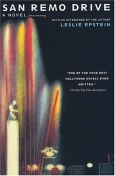BKMT READING GUIDES
San Remo Drive: A Novel from Memory
by Leslie Epstein
Paperback : 272 pages
0 club reading this now
0 members have read this book
Introduction
Leslie Epstein's new novel, set in Los Angeles in the 1950s and then, in a long final section, in 2000, depicts the Jacobis, the family of a famous film writer and director. Their story is told by Richard Jacobi, the elder son, at the summit of his career as a painter. In five extended narratives, the novel traces the trajectory of Richard's self-awareness as he comes to terms with the death of his principled father and its lasting effects on his mother, brother, and himself. At the same time, the novel meditates on the status of Jews and African-Americans in the U.S. after World War II, and beautifully evokes the landscape of Southern California in its last days before the migration to it of millions.
“One of the four best Hollywood novels ever written.” —Elizabeth Frank, New York Times Book Review
“Epstein is a master storyteller at the height of his powers.” —Jonathan Kirsch, Los Angeles Times Book Review
“Mr. Epstein effortlessly captures the magic of a Hollywood childhood . . . San Remo Drive is a haunting and deeply affecting book.” —Michiko Kakutani, New York Times
Excerpt
The sun was where it always was, high overhead, though on the particular Sunday I have in mind it had to force its way through a thin layer of cloud that stretched above us like a sheet of wax paper. I assume it was Sunday: we weren't in school, Barton and I, and it wasn't warm enough yet for summer. In spite of the cool weather, I'd put down the top on the Buick we owned back in the Fifties. As we made our way in traffic along the Pacific Coast Highway, Sam, our spaniel, leaned out from the back seat, nose up, ears blown inside out. My brother hung onto his leash, lest at the sight of a skunk or a cat or--rising out of the haze-hung ocean--a silvery dolphin, he leap into the opposing stream of cars. Lotte, our mother, sat beside me, clutching a scarf over the permanent wave she'd set in her hair. ...Discussion Questions
Discussion Questions from the Publisher:1. At his mother’s funeral, Richard recounts his earliest memory, and in his afterword the author explains its resonance. What is your earliest memory? Does it have any particular feelings associated with it, or any connection to later events in your life?
2. The novel’s central location is the house on San Remo Drive, of which there is a picture at the front of the book. In his afterword, the author states, “Everyone has a particular home in their past—often from early adolescence—that has been imprinted on their experience and that will always be theirs. . .” Do you have a home of that importance in your past? What are your strongest memories set in that place?
3. In “Tijuana” and then later, in “San Remo Drive,” the narrator places special emphasis on the electric fountain at the corner of Wilshire and Santa Monica Boulevard. How does Bartie’s visit to his Swami color Richard’s impression of the fountain? What does their conversation suggest about the period they were living in? Does this foreshadow the death at the end of the novel?
4. What is the connection between art and sex in the novel? What episodes would suggest a connection? Are they inextricably linked, at least for the narrator?
5. When Richard and Bartie view their father’s testimony in front of the House Un-American Activies Committee, their personal lives intersect with the historical. What other instances show the force of history shaping the lives of the characters in the novel? What is the relationship between memory and history in the novel?
6. As a “novel from memory,” San Remo Drive is grounded in the specific, personal recollections and impressions of its main character. However, the larger social setting that encircles the events of the novel introduces themes of race, class, politics and art, as questions 4 and 5 suggest. What does the novel have to say about these larger issues that hasn’t already been discussed?
Notes From the Author to the Bookclub
Leslie Epstein asks: Is this a Hollywood novel? Is it simply located in Hollywood or is the book saturated by films and film culture? The book is called A Novel from Memory. What does that mean? How much of the book is fiction, how much is remembered? Does the distinction matter? At the end of the book we leap ahead almost fifty years. Does the reader take that jump as well? Do we see, in these adults, especially Richard, Bartie, Madeline, the children we have spent so much time with in the past?Book Club Recommendations
Recommended to book clubs by 0 of 0 members.
Now serving over 80,000 book clubs & ready to welcome yours. Join us and get the Top Book Club Picks of 2022 (so far).
Get free weekly updates on top club picks, book giveaways, author events and more








